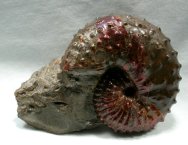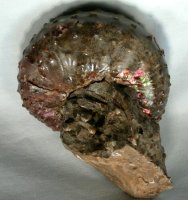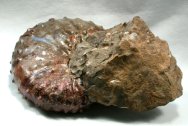Name: Discoscaphites
conradi
Phylum Mollusca; Class Cephalopoda; Subclass Ammonoidea;
Order Ammonitida
Geological
Time: Upper Cretaceous
Size (25.4
mm = 1 inch): 85 mm across on a 58 mm by 70 mm matrix base
Fossil Site:
Fox Hills Formation, North Central South Dakota
 Description:
A magnificent example of the ammonite Discoscaphites conradi of the
Fox Hills Formation deposits of South Dakota. During the Cretaceous,
much of the Western United States was covered by what is termed the
Western Interior Seaway, a broad shallow (100-300 m maximum depth)
sea that was home to various aquatic reptiles, fish, and ammonites.
It was open to the North to Canada’s boreal seas and to the
South to what is now the present-day Gulf of Mexico. During the Late
Cretaceous, fluctuations in the sea level led to various bouts of
exposure of some regions; as a consequence, there is some intertonguing
of terrestrial deposits, the most famous of which is Hell Creek, home
of T. rex. Ammonites of this degree of preservation are difficult
to come across. The high degree of preservation of its natural mother-of-pearl
shell makes it appear to be preserved as fire opal. This is a consequence
of light passing through the various layers of aragonite and conchiolin
deposited by the ammonite in life. Conchiolin is secreted by various
other mollusks, including oysters, and is a complex protein. Notice
how the colors change with changing perspective. This is an stunning
example of this flashy ammonite. Description:
A magnificent example of the ammonite Discoscaphites conradi of the
Fox Hills Formation deposits of South Dakota. During the Cretaceous,
much of the Western United States was covered by what is termed the
Western Interior Seaway, a broad shallow (100-300 m maximum depth)
sea that was home to various aquatic reptiles, fish, and ammonites.
It was open to the North to Canada’s boreal seas and to the
South to what is now the present-day Gulf of Mexico. During the Late
Cretaceous, fluctuations in the sea level led to various bouts of
exposure of some regions; as a consequence, there is some intertonguing
of terrestrial deposits, the most famous of which is Hell Creek, home
of T. rex. Ammonites of this degree of preservation are difficult
to come across. The high degree of preservation of its natural mother-of-pearl
shell makes it appear to be preserved as fire opal. This is a consequence
of light passing through the various layers of aragonite and conchiolin
deposited by the ammonite in life. Conchiolin is secreted by various
other mollusks, including oysters, and is a complex protein. Notice
how the colors change with changing perspective. This is an stunning
example of this flashy ammonite. |
|



